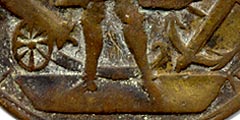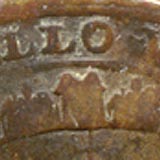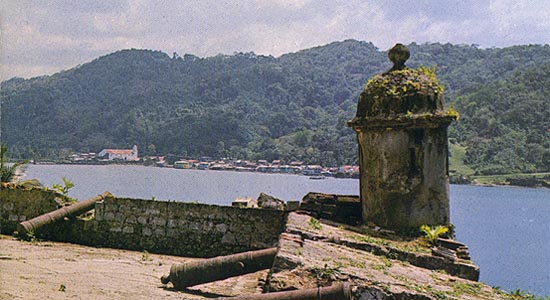| Obverse Design | Legend curving above says "THE . BRITISH : GLORY . REVIV . D . BY . ADMIRAL : VERNON" ("N"'s reversed). There is a faint inside line enclosing the legend. In the center is a full length figure of Admiral Vernon with his body turned to our left (facing left), and standing on a platform. Vernon is holding a baton in his left hand, and his right hand is pointing toward the letter "T". To our left of Admiral Vernon is a canon whose trail goes behind the Admiral. To our right of the Admiral is an anchor. The medal has a smooth plain raised edge. | ||||||
| Reverse Design | Legend curving along the top says "HE TOOK PORTO BELLO WITH SIX SHIPS ONLY". There is an inside line enclosing the legend. In exergue (under a line along the bottom of the medal) it has the date: "NOV . 22 . 1739" ("N" reversed). There are no ornaments below the date. The center is the attack on Portobello. The six ships are lined up two in the top row, one below and in front of the first two, and the last three in the bottom row. All the ships are sailing to our right. There are at least two small vessels in the harbor. A building with two gables points to "LO". The medal has a smooth plain raised edge. | ||||||
| Distinctions | There are only two varieties with a cannon, full-length Vernon and an anchor in that order (there are a two others with the anchor, Vernon and the cannon in that order). Of these two, one is slightly larger (37 mm versus 36 mm) and has a dot between the "L" and "O" of "BELLO". The smaller one is sometimes seen silver-plated. | ||||||
| Detail On Obverse of VN-2.121 | Detail On Reverse of VN-2.121 | ||||||
 Close-up of Cannon, Vernon's feet and anchor on platform. |
 Note the lack of a dot between "L" and "O". |
||||||
| Metal | Copper and Silver-plated. | Weight | Unknown. | Size and Shape | Round, 36 mm in diameter. | ||
| Rarity | Scarce. | Designer or Issuer | Not known. | Other Catalog Numbers | McCormick-Goodhart #98A, Betts #223. | Population Count |
Recent sales include:
|
| Notes |
The example above appears to have been silver-plated originally.
Fort San Fernando shown below was built in 1753 as part of the project of rebuilding the fortifications of Portobello after Admiral Vernon destroyed them in 1739. |
||||||

From the Canal Zone Review, Fall 1971 Edition